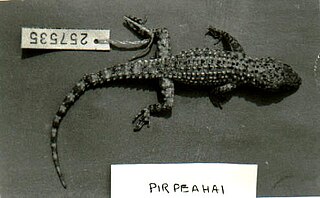
Gekkonidae is the largest family of geckos, containing over 950 described species in 64 genera. Members of the Gekkonidae comprise many of the most widespread gecko species, including house geckos (Hemidactylus), tokay geckos (Gekko), day geckos (Phelsuma), mourning geckos (Lepidodactylus) and dtellas (Gehyra). Gekkonid geckos occur globally and are particularly species-rich in tropical areas.

The Batura Glacier gecko, also known as the Batura thin-toed gecko, is a species of gecko found in Pakistan and India.
Cyrtopodion kachhense, also known commonly as the Kachh gecko, the warty rock gecko, the ingoldbyi western ground gecko, or Ingoldby's stone gecko, is a species of gecko, a lizard in the family Gekkonidae. The species is endemic to South Asia.

Staurotypus is a genus of aquatic turtles, commonly known as giant musk turtles, Mexican musk turtles, or three-keeled musk turtles, in the family Kinosternidae. The genus contains two recognized species, which are endemic to Mexico and Central America. Both species are sold and bred as pets.

Apalone is a genus of turtles in the family Trionychidae. Species of Apalone are native to North America.

Actinemys is a small genus of turtles in the family Emydidae. The genus is endemic to the west coast of North America. The genus contains two species.

Diploglossidae is a family of anguimorph lizards native to the Americas, with most genera being endemic to Hispaniola. Most members of this family are known as galliwasps. They were formerly considered a subfamily of Anguidae, but genetic evidence has shown them to be less closely related to other members of Anguidae than Anniellidae is.

The Fort Munro sandstone gecko is a species of gecko, a lizard in the family Gekkonidae. The species is endemic to Pakistan.

The Sulaiman Range gecko is a species of gecko, a lizard in the family Gekkonidae. The species is endemic to northwestern Pakistan.
Cyrtopodion medogense is a species of gecko, a lizard in the family Gekkonidae. The species is endemic to western China.

The Salt Range gecko is a species of gecko, a lizard in the family Gekkonidae. The species is endemic to northern Pakistan.
The rosy-tailed sandstone gecko is a species of gecko, a lizard in the family Gekkonidae. The species is endemic to Balochistan, Pakistan.

Tenuidactylus bogdanovi is a species of gecko, a lizard in the family Gekkonidae. The species is native to Central Asia.

Tenuidactylus caspius, also known as the Caspian bent-toed gecko or Caspian thin-toed gecko, is a species of gecko that ranges widely from southwestern Kazakhstan, southern Tajikistan, Turkmenistan and Uzbekistan west to southern Russia, Georgia, Armenia and Azerbaijan, south to Iran and northern Afghanistan.
Tenuidactylus dadunensis is a species of gecko that is endemic to China.

The Turkestan thin-toed gecko, also known commonly as Fedtschenko's bow-fingered gecko and Fedtschenko's grasping gecko, is a species of lizard in the family Gekkonidae. The species is native to Central Asia.

Tenuidactylus longipes, also known as Nikolsky's long-toed gecko or the long-legged thin-toed gecko, is a species of gecko that is found in Iran and southern Turkmenistan. The subspecies microlepis is sometimes considered a distinct species.
The Turkmenian thin-toed gecko is a species of gecko that is found in eastern Turkmenistan and northern Afghanistan.
The southwest thin-toed gecko is a species of gecko that is endemic to Afghanistan.













